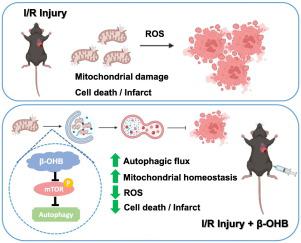Journal of Molecular and Cellular Cardiology ( IF 5 ) Pub Date : 2023-11-16 , DOI: 10.1016/j.yjmcc.2023.11.001 Yuxin Chu 1 , Yutao Hua 2 , Lihao He 2 , Jin He 2 , Yunxi Chen 2 , Jing Yang 2 , Ismail Mahmoud 2 , Fanfang Zeng 3 , Xiaochang Zeng 3 , Gloria A Benavides 4 , Victor M Darley-Usmar 4 , Martin E Young 2 , Scott W Ballinger 4 , Sumanth D Prabhu 2 , Cheng Zhang 5 , Min Xie 2

|
Ischemia/reperfusion (I/R) injury after revascularization contributes ∼50% of infarct size and causes heart failure, for which no established clinical treatment exists. β-hydroxybutyrate (β-OHB), which serves as both an energy source and a signaling molecule, has recently been reported to be cardioprotective when administered immediately before I/R and continuously after reperfusion. This study aims to determine whether administering β-OHB at the time of reperfusion with a single dose can alleviate I/R injury and, if so, to define the mechanisms involved. We found plasma β-OHB levels were elevated during ischemia in STEMI patients, albeit not to myocardial protection level, and decreased after revascularization. In mice, compared with normal saline, β-OHB administrated at reperfusion reduced infarct size (by 50%) and preserved cardiac function, as well as activated autophagy and preserved mtDNA levels in the border zone. Our treatment with one dose β-OHB reached a level achievable with fasting and strenuous physical activity. In neonatal rat ventricular myocytes (NRVMs) subjected to I/R, β-OHB at physiologic level reduced cell death, increased autophagy, preserved mitochondrial mass, function, and membrane potential, in addition to attenuating reactive oxygen species (ROS) levels. ATG7 knockdown/knockout abolished the protective effects of β-OHB observed both in vitro and in vivo. Mechanistically, β-OHB's cardioprotective effects were associated with inhibition of mTOR signaling. In conclusion, β-OHB, when administered at reperfusion, reduces infarct size and maintains mitochondrial homeostasis by increasing autophagic flux (potentially through mTOR inhibition). Since β-OHB has been safely tested in heart failure patients, it may be a viable therapeutic to reduce infarct size in STEMI patients.
中文翻译:

再灌注时给予β-羟基丁酸盐可通过自噬改善雄性小鼠的线粒体功能,从而减少梗死面积并保留心脏功能
血运重建后的缺血/再灌注 (I/R) 损伤占梗死面积的 50%,并导致心力衰竭,目前尚无成熟的临床治疗方法。β-羟基丁酸 (β-OHB) 既可作为能量来源,又可作为信号分子,最近有报道称,在 I/R 之前和再灌注后持续给药时,具有心脏保护作用。本研究旨在确定再灌注时单剂量施用 β-OHB 是否可以减轻 I/R 损伤,如果可以,则明确其相关机制。我们发现STEMI患者缺血期间血浆β-OHB水平升高,尽管未达到心肌保护水平,但在血运重建后血浆β-OHB水平降低。在小鼠中,与生理盐水相比,再灌注时给予 β-OHB 可以减少梗塞面积(减少 50%),保留心脏功能,并激活自噬并保留边界区的 mtDNA 水平。我们用一剂 β-OHB 进行的治疗达到了禁食和剧烈体力活动可达到的水平。在遭受 I/R 的新生大鼠心室肌细胞 (NRVM) 中,生理水平的 β-OHB 除了降低活性氧 (ROS) 水平外,还可以减少细胞死亡,增加自噬,保留线粒体质量、功能和膜电位。ATG7 敲低/敲除消除了在体外和体内观察到的 β-OHB 的保护作用。从机制上讲,β-OHB 的心脏保护作用与mTOR 信号传导的抑制有关。总之,再灌注时给予 β-OHB 可以减少梗死面积,并通过增加自噬通量(可能通过 mTOR 抑制)维持线粒体稳态。由于 β-OHB 已在心力衰竭患者中进行了安全测试,因此它可能是减少 STEMI 患者梗塞面积的可行治疗方法。



























 京公网安备 11010802027423号
京公网安备 11010802027423号